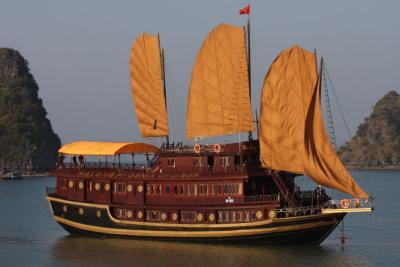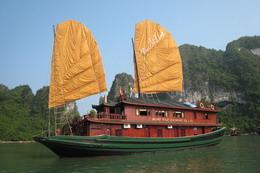| Chau van or hat van is a traditional Vietnamese folk art which combines trance singing and dancing. Its music and poetry are combined with a variety of instruments, rhythms, pauses, and tempos. Hat chau van originated in the 16th century and spread quickly. The main musical instrument used in hat van performance is the dan nguyet or moon-shaped lute. The genre is famous for its use in rituals for deity mediumship. Chau Van serves two purposes: to help hypnotize the medium to receive the deities and to accompany the medium’s actions with appropriate music. Cheo is a form of generally satirical musical theatre, often encompassing dance, traditionally performed by Vietnamese peasants in northern Vietnam. It is usually performed outdoors by semi-amateur touring groups in a village square or the courtyard of a public building, although it is today increasingly also performed indoors and by professional performers. Quan ho singing is a Vietnamese folk music style characterized both by its antiphonal nature, with alternating groups of female and male singers issuing musical challenges and responses, and by the fact that most of the songs in the repertoire deal with topics of love and sentimentality. Quan ho was recognised as a UNESCO Intangible Cultural Heritage in 2009. Quan ho originated in what is now Bac Ninh Province, was first recorded in the 13th century and has traditionally been associated with the spring festivals that follow the celebration of Tet (the Vietnamese New Year). There are a huge number of quan ho melodies, with thousands of different songs recorded and written down. Ca tru (also known as hat a dao) is an ancient genre of chamber music featuring female vocalists, with origins in northern Vietnam. For much of its history, it was associated with a geisha-like form of entertainment. Ca tru is inscribed on the list of Intangible Cultural Heritage in need of Urgent Safeguarding in 2009. Xam or hat xam (Xam singing) is a type of Vietnamese folk music popularized in northern Vietnam, but is considered nowadays as an endangered form of traditional music. In the dynastic period, xam was generally performed by blind artists who wandered from town to town and earned their living by singing in common areas. Xam artists often play dan bau or dan nhi to accompany the songs themselves, sometimes they form a band with one singer and others who play traditional instruments such as drum or phach. Dan bau is a Vietnamese monochord. While the earliest written records of the Dan Bau date its origin to 1770, many scholars estimate its age to be up to one thousand years older than that. Water puppetry is a tradition that dates back as far as the 11th century CE when it originated in the villages of the Red River Delta area of northern Vietnam. Today’s Vietnamese water puppetry is a unique variation on the ancient Asian puppet tradition. The puppets are made out of wood and then lacquered. The shows are performed in a waist-deep pool. A large rod supports the puppet under the water and is used by the puppeteers, who are normally hidden behind a screen, to control them. Thus the puppets appear to be moving over the water. When the rice fields would flood, the villagers would entertain each other using this form of puppet play. | 












